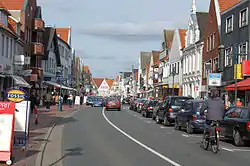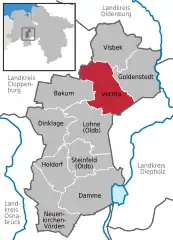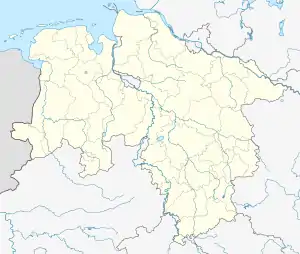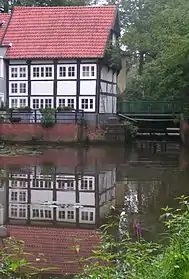Vechta
Vechta (German pronunciation: [ˈfɛçta]) with a population of nearly 32,000 is the biggest city and also the capital of the Vechta district in Lower Saxony, Germany. It is home to the University of Vechta.
Vechta | |
|---|---|
 | |
 Coat of arms | |
Location of Vechta within Vechta district  | |
 Vechta  Vechta | |
| Coordinates: 52°43′50″N 08°17′19″E | |
| Country | Germany |
| State | Lower Saxony |
| District | Vechta |
| Subdivisions | 25 |
| Government | |
| • Mayor | Kristian Kater (SPD) |
| Area | |
| • Total | 87.8 km2 (33.9 sq mi) |
| Elevation | 37 m (121 ft) |
| Population (2019-12-31)[1] | |
| • Total | 32,863 |
| • Density | 370/km2 (970/sq mi) |
| Time zone | UTC+01:00 (CET) |
| • Summer (DST) | UTC+02:00 (CEST) |
| Postal codes | 49377 |
| Dialling codes | 04441 |
| Vehicle registration | VEC |
| Website | www.vechta.de |
It is known for the 'Stoppelmarkt' fair, which takes place every summer and has a history dating back to 1298. With an attendance of 800,000 visitors it is one of the biggest annual fairs in north-western Germany.[2]
The town was in the recent past known as a centre of far northern German Catholicism.

Town subdivisions
Vechta consists of 25 boroughs, but the city proper was made out of 16 boroughs, until in 1933 the three boroughs of the old "Community of Oythe" were added to the city. The six boroughs of the "Community of Langförden" were added to the city in 1974.
|
|
|
|
|
Transport and infrastructure
The A1, also known as the Hansalinie, passes by Vechta. There are three interchanges: Vechta-West/Bakum, Vechta-Langförden/Emstek, Vechta-Nord/Ahlhorn . Also, the B69 runs through the city of Vechta.
Transport
Vechta lies on the Delmenhorst-Hesepe railway and offers connections to Osnabrück and Bremen.
Population development
Vechta has become a very rich city with a high quality of living, so Vechta is one of the rare German towns that still has a growing population.
|
|
|
Theatre
Vechta is a fixed venue for the Landesbühne Niedersachsen Nord, founded in 1952. The headquarter is located in Wilhelmshaven, which stages annually up to ten performances at the Metropoltheater. The theatre offers 272 seats.
Climate
The climate in Vechta is a moderate sea climate, influenced by wet northwest winds from the North Sea. The long term average air temperature reaches 8.5 to 9.0°C and about 700 millimeters of rainfall per year. Between May and August, an average of 20 - 25 summer days (climatological term for days with the maximum temperature exceeds 25°C) are calculated.
Twin towns
 Pays Léonard, France
Pays Léonard, France Saint-Pol-de-Léon, France
Saint-Pol-de-Léon, France Jászberény, Hungary
Jászberény, Hungary Seguin, Texas
Seguin, Texas Starachowice, Poland
Starachowice, Poland
Sport
Vechta is home of the Rasta Vechta, basketball club which plays in German Basketball Bundesliga.
Notable people
- Andreas Romberg (1767–1821), composer and violin player

- Rolf Dieter Brinkmann (1940–1975), lyrician
- Ansgar Brinkmann (born 1969), football player
- Martin Welzel (born 1972), organist, musicologist, and music educator
- Katja Suding (born 1975), politician
- Alparslan Erdem (born 1988), football player
See also
References
- Landesamt für Statistik Niedersachsen, LSN-Online Regionaldatenbank, Tabelle 12411: Fortschreibung des Bevölkerungsstandes, Stand 31. Dezember 2019.
- "Archived copy". Archived from the original on 2015-05-02. Retrieved 2015-04-21.CS1 maint: archived copy as title (link)